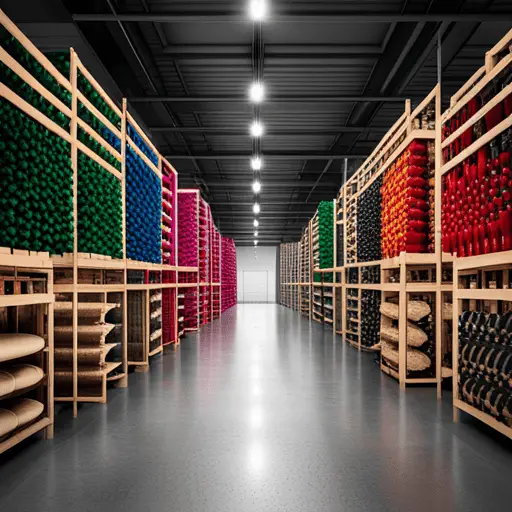You may not think about it often, but ink production is a complex and intricate process that has a significant impact on the environment. The ink that flows from your pen or printer cartridge has a story, and it’s one that is worth exploring.
Like a river carving its way through a canyon, ink production has carved its mark on the environment, leaving behind a trail of pollution and waste. But there is hope. Just as a river can change its course, so too can the ink industry change its ways.
Sustainable ink production practices are emerging, and with them comes the potential for a cleaner, greener future. As a consumer, you have the power to influence this change by making informed choices and demanding accountability from ink manufacturers.
Let’s dive into the environmental impact of ink production, and explore how we can turn the tide towards a more sustainable future.
Key Takeaways
– Ink production has a large carbon footprint and generates a lot of waste, including leftover chemicals and packaging materials, which can contaminate soil and water sources.
– Efforts to improve ink production sustainability include the use of renewable energy sources, eco-friendly ingredients such as vegetable-based and soy-based inks, sustainable production practices, and investing in carbon offset programs.
– Consumers can make a positive impact on ink production sustainability by choosing eco-friendly ink options and recycling ink cartridges. Consumer education is also important in promoting ethical consumption and holding companies accountable.
– The future of ink production sustainability includes the use of green technologies, plant-based materials in ink formulations, and support for the circular economy. Small steps towards sustainability can create a positive impact on the environment and contribute to a healthier planet.
Overview of Ink Production Processes

You’re probably not aware of it, but every time you use an ink pen or print a document, you’re contributing to the environmental damage caused by the complex and energy-intensive process of ink production.
Ink production involves a series of processes that require a lot of energy and materials, including the extraction and refining of raw materials, chemical reactions, and packaging.
All of these processes have significant environmental impacts, from greenhouse gas emissions to water pollution.
To mitigate the environmental impact of ink production, companies are constantly looking for ways to improve ink production efficiency and waste management.
For instance, some companies are exploring the use of renewable energy sources, such as solar and wind power, to power their ink production facilities.
Others are investing in technologies that reduce chemical waste and water consumption.
By adopting these measures, ink producers can reduce their carbon footprint and minimize their impact on the environment.
Environmental Impact of Ink Production

Hey, did you know that every time you print a document, you’re contributing to a much larger problem? The ink production process has a significant environmental impact, and it’s important to understand how this process affects our planet.
Here are some things you may not know about the environmental impact of ink production:
– Ink production has a large carbon footprint. The manufacturing process requires a lot of energy, and the transportation of materials and finished products adds to the carbon emissions.
– The chemicals used in ink production can be harmful to the environment. Many of these chemicals are toxic and can contaminate soil and water sources if not properly disposed of.
– Ink production generates a lot of waste. Unused ink, packaging materials, and leftover chemicals all contribute to the waste produced by the industry.
– Recycling ink cartridges can help reduce waste. Many ink cartridges can be refilled and reused, reducing the number of cartridges that end up in landfills.
– Proper waste management is crucial. Ink manufacturers must ensure that any waste produced is disposed of safely and responsibly to minimize the environmental impact.
As consumers, we can make a difference by choosing eco-friendly ink options and recycling our ink cartridges. By being conscious of the environmental impact of ink production, we can help reduce our carbon footprint and make a positive impact on the planet.
Sustainable Ink Production Practices

Nowadays, ink manufacturers are implementing more sustainable practices to minimize their carbon footprint and decrease waste. Eco-friendly ingredients, such as vegetable-based inks and soy-based inks, are being used in the production process. These alternatives have a lower environmental impact than traditional petroleum-based inks, which release volatile organic compounds (VOCs) into the atmosphere.
In addition to using eco-friendly ingredients, ink manufacturers are also reducing their carbon footprint by implementing energy-efficient practices. This includes using renewable energy sources, such as solar and wind power, to power their production facilities. Some ink manufacturers are even investing in carbon offset programs to balance out any remaining emissions.
By adopting these sustainable practices, ink manufacturers are not only reducing their impact on the environment, but also meeting the demands of consumers who prioritize environmentally-friendly products.
Certification and Standards

So, you’re curious about certification and standards when it comes to sustainable ink production? Well, let’s start with eco-labels and certifications, which provide third-party verification that a product meets certain environmental standards.
Look for labels like the Forest Stewardship Council (FSC) or the Program for the Endorsement of Forest Certification (PEFC) to ensure that the paper used in your ink production is sustainably sourced.
Additionally, compliance with environmental regulations is a must for any responsible ink manufacturer. Make sure your ink supplier is following regulations set by organizations like the Environmental Protection Agency (EPA) to ensure that their production practices are not harming the environment.
Eco-labels and certifications
With the growing concern for environmental impact, eco-labels and certifications have become a valuable tool for consumers to make more informed choices about the ink products they purchase. Eco-friendly packaging and green marketing have become buzzwords in the industry, signaling a shift towards more sustainable practices.
Eco-labels, such as the Forest Stewardship Council (FSC) and Program for the Endorsement of Forest Certification (PEFC), certify that the paper used in ink production comes from sustainable sources. Similarly, certifications like the European Ecolabel and the Blue Angel ensure that ink products meet strict environmental standards, including reduced toxicity and harmful emissions.
As a consumer, you have the power to make a difference in the environmental impact of ink production. By choosing ink products with eco-labels and certifications, you can support companies that prioritize sustainable practices and reduce your own environmental footprint. Additionally, you can look for companies that use eco-friendly packaging, such as recycled materials or biodegradable alternatives, to further minimize waste.
With the increasing availability of eco-labels and certifications, it’s never been easier to make a conscious choice for the environment.
Compliance with environmental regulations
You can easily ensure that the ink products you purchase are in line with the latest regulations for protecting the planet by checking for compliance with contemporary environmental rules. These regulations might include emissions reduction and waste management practices that minimize the impact of ink production on the environment. By choosing to support ink manufacturers that prioritize sustainability, you’re contributing to a world where innovation and environmental responsibility go hand-in-hand.
Compliance with environmental regulations is a critical component of ensuring that the ink products you purchase are produced in a way that’s safe for the planet. This might involve using environmentally friendly materials during the production process, implementing energy-efficient practices that reduce emissions, and adopting sustainable waste management practices.
By checking for compliance with these regulations, you’re choosing to support ink manufacturers who are committed to minimizing their environmental impact and promoting a healthier, more sustainable world for all of us.
Consumer Awareness and Responsibility

As consumers, we can make a positive impact on the environment by choosing eco-friendly ink products. Consumer education is key to increasing awareness about the environmental impact of ink production. By understanding the harmful effects of traditional ink production, we can make informed decisions about the products we purchase and use.
Ethical consumption is also important in reducing our environmental footprint. By choosing companies that prioritize sustainability and ethical practices in their production processes, we can support a healthier planet.
As consumers, we have the power to demand eco-friendly options and hold companies accountable for their environmental impact. Let’s take responsibility for our actions and make a conscious effort to choose eco-friendly ink products.
Together, we can make a difference in protecting our planet.
Future of Sustainable Ink Production

Now that you’re more aware of your responsibility as a consumer, let’s talk about the future of sustainable ink production. The good news is that the industry is already moving towards more eco-friendly practices. Green technologies, such as using renewable energy sources and reducing waste in the production process, are becoming more prevalent.
In addition, some companies are exploring the possibility of using plant-based materials in their ink formulations. But sustainability doesn’t end with production. The circular economy is gaining traction as a way to minimize waste and create a more sustainable future.
This approach involves designing products and processes with the intent of keeping materials in use for as long as possible, rather than discarding them after a single use. As a consumer, you can support this movement by choosing to purchase ink cartridges that are refillable or made from recycled materials.
By taking small steps towards sustainability, we can create a future where ink production has a minimal impact on the environment.
Conclusion
Congratulations! You’re now aware of the environmental impact of ink production. As a consumer, you can make a difference by choosing to use sustainable ink products. By doing so, you’re not only reducing your carbon footprint but also supporting companies that prioritize protecting the environment.
Remember, the future of sustainable ink production is in our hands. Let’s commit to making informed choices and supporting businesses that adopt sustainable practices. Together, we can make a significant impact and preserve the planet for future generations.
So, let’s take action and start making a positive change today! As the saying goes, “Every little bit helps, and together, we can move mountains.”
